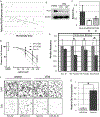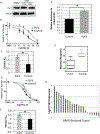The role of polo-like kinase 3 in the response of BRAF-mutant cells to targeted anticancer therapies
- PMID: 31571292
- PMCID: PMC6908756
- DOI: 10.1002/mc.23123
The role of polo-like kinase 3 in the response of BRAF-mutant cells to targeted anticancer therapies
Abstract
The activation of oncogenic mitogen-activated protein kinase cascade via mutations in BRAF is often observed in human melanomas. Targeted inhibitors of BRAF (BRAFi), alone or as a part of a combination therapy, offer a significant benefit to such patients. Unfortunately, some cases are initially nonresponsive to these drugs, while others become refractory in the course of treatment, underscoring the need to understand and mitigate the underlying resistance mechanisms. We report that interference with polo-like kinase 3 (PLK3) reduces the tolerance of BRAF-mutant melanoma cells to BRAFi, while increased PLK3 expression has the opposite effect. Accordingly, PLK3 expression correlates with tolerance to BRAFi in a panel of BRAF-mutant cell lines and is elevated in a subset of recurring BRAFi-resistant melanomas. In PLK3-expressing cells, R406, a kinase inhibitor whose targets include PLK3, recapitulates the sensitizing effects of genetic PLK3 inhibitors. The findings support a role for PLK3 as a predictor of BRAFi efficacy and suggest suppression of PLK3 as a way to improve the efficacy of targeted therapy.
Keywords: BRAF; PLK3; R406; cobimetinib; vemurafenib.
© 2019 Wiley Periodicals, Inc.
Figures




Similar articles
-
Immunomodulatory effects of BRAF and MEK inhibitors: Implications for Melanoma therapy.Pharmacol Res. 2018 Oct;136:151-159. doi: 10.1016/j.phrs.2018.08.019. Epub 2018 Aug 23. Pharmacol Res. 2018. PMID: 30145328 Review.
-
Indoleamine 2,3-dioxygenase in melanoma progression and BRAF inhibitor resistance.Pharmacol Res. 2020 Sep;159:104998. doi: 10.1016/j.phrs.2020.104998. Epub 2020 Jun 11. Pharmacol Res. 2020. PMID: 32535222
-
Dual MAPK Inhibition Is an Effective Therapeutic Strategy for a Subset of Class II BRAF Mutant Melanomas.Clin Cancer Res. 2018 Dec 15;24(24):6483-6494. doi: 10.1158/1078-0432.CCR-17-3384. Epub 2018 Jun 14. Clin Cancer Res. 2018. PMID: 29903896
-
Vemurafenib Drives Epithelial-to-Mesenchymal Transition Gene Expression in BRAF Inhibitor‒Resistant BRAFV600E/NRASQ61K Melanoma Enhancing Tumor Growth and Metastasis in a Bioluminescent Murine Model.J Invest Dermatol. 2022 May;142(5):1456-1465.e1. doi: 10.1016/j.jid.2021.10.007. Epub 2021 Oct 21. J Invest Dermatol. 2022. PMID: 34687745 Free PMC article.
-
A Review of the Molecular Pathways Involved in Resistance to BRAF Inhibitors in Patients with Advanced-Stage Melanoma.Med Sci Monit. 2020 Apr 10;26:e920957. doi: 10.12659/MSM.920957. Med Sci Monit. 2020. PMID: 32273491 Free PMC article. Review.
Cited by
-
Comprehensive analysis reveals PLK3 as a promising immune target and prognostic indicator in glioma.Oncol Res. 2025 Jan 16;33(2):431-442. doi: 10.32604/or.2024.050794. eCollection 2025. Oncol Res. 2025. PMID: 39866232 Free PMC article.
-
High PLK3 levels are linked with less tumor invasion, lower FIGO stage and better prognosis of endometrial cancer.Biomark Med. 2024;18(10-12):523-533. doi: 10.1080/17520363.2024.2347192. Epub 2024 May 24. Biomark Med. 2024. PMID: 39082977 Free PMC article.
-
Mechanisms of Acquired BRAF Inhibitor Resistance in Melanoma: A Systematic Review.Cancers (Basel). 2020 Sep 29;12(10):2801. doi: 10.3390/cancers12102801. Cancers (Basel). 2020. PMID: 33003483 Free PMC article. Review.
-
PAK1 and Therapy Resistance in Melanoma.Cells. 2023 Sep 28;12(19):2373. doi: 10.3390/cells12192373. Cells. 2023. PMID: 37830586 Free PMC article. Review.
-
Genome-wide CRISPR-cas9 knockout screening identifies GRB7 as a driver for MEK inhibitor resistance in KRAS mutant colon cancer.Oncogene. 2022 Jan;41(2):191-203. doi: 10.1038/s41388-021-02077-w. Epub 2021 Oct 30. Oncogene. 2022. PMID: 34718347 Free PMC article.
References
-
- Hauschild A, Grob JJ, Demidov LV, et al. Dabrafenib in BRAF-mutated metastatic melanoma: a multicentre, open-label, phase 3 randomised controlled trial. Lancet. 2012;380(9839):358–365. - PubMed
-
- Ascierto PA, Minor D, Ribas A, et al. Phase II trial (BREAK-2) of the BRAF inhibitor dabrafenib (GSK2118436) in patients with metastatic melanoma. J Clin Oncol. 2013;31(26):3205–3211. - PubMed
-
- Long GV, Stroyakovskiy D, Gogas H, et al. Combined BRAF and MEK inhibition versus BRAF inhibition alone in melanoma. The New England journal of medicine. 2014;371(20):1877–1888. - PubMed
Publication types
MeSH terms
Substances
Grants and funding
LinkOut - more resources
Full Text Sources
Medical
Research Materials

